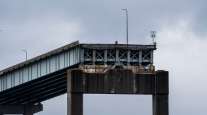U.S. Bridge Spending Lags as Repair Needs Dwarf Funds
This story appears in the Aug. 19 print edition of Transport Topics.
Despite the nation’s efforts to upgrade its bridges in recent years, a staggering 151,500 are still labeled as deficient, the cure for which is to spend $20.5 billion every year between now and 2028.
That estimate comes from the Federal Highway Administration, which oversees the health of the nation’s bridges and which says that current spending on the spans is $12.8 billion annually.
“We’ve made a lot of progress, thanks in part to the Recovery Act, which allowed us to repair or replace more than 2,700 bridges,” FHWA Administrator Victor Mendez said of the billions of dollars pumped into the economy during the recession. “Still, there is a lot of work to be done.”
As quickly as some bridges are taken off the deficient list, others are added, a situation that weighs on states such as New Hampshire.
“Since 2000, we’ve removed 200 bridges from the state’s ‘red list’ and we’ve added another 196, so in 13 years we got a net gain of four bridges,” said Bill Boynton, spokesman for the New Hampshire Department of Transportation.
“Red list” is the term the state uses for bridges that need work because of deficiencies or repair needs.
One big crossing in New Hampshire, the Memorial Bridge, was removed from the red list Aug. 8 — to the delight of hundreds of revelers, public officials and brass and bagpipe bands that swarmed the reopened bridge that connects Portsmouth, N.H., and Kittery, Maine, home to the Portsmouth Naval Shipyard.
Of the $81.4 million spent to rebuild the span, $20 million came from a grant program under the American Recovery and Reinvestment Act of 2009.
The closing two years ago of the badly deteriorated span severed the communities that face each other across the Piscataqua River.
“It was an interruption of commerce, and it definitely affected businesses,” Boynton said.
Like New Hampshire, the country as a whole is plagued with aging bridges, according to Boynton and the American Society of Civil Engineers, among others.
“The average New Hampshire bridge is 54 years old,” Boynton said.
And newer bridges have been at the center of tragedies.
The Interstate 35 bridge in Minneapolis that collapsed in August 2007, killing 13 people, was only 40 years old.
Since 2009, though, the nation has removed 8,300 bridges from FHWA’s list of deficient spans, and the civil engineers have noted the progress. The ASCE this year gave America’s crossings a C+ on the infrastructure report card it issues every four years. That’s up from a grade of C in 2009.
Like FHWA, however, ASCE qualifies the progress.
“One in nine bridges in this country is still considered structurally deficient,” said Robert Victor, chairman of the ASCE committee that produced the report card.
“In general, our bridge inventory’s old,” Victor said. “The average age . . . is over 40 years old, and these things weren’t designed to last forever, and the materials don’t last forever.
“And obviously, the amount of traffic and the amount of wear and tear these bridges are seeing today is not what they were designed for 40-something years ago.”
Take the Skagit River bridge collapse in May in Washington State. A truck hauling a massive piece of oil-drilling equipment (for which it had a special permit) clipped a steel truss on the 58-year-old structure.
The bridge was classified as “fracture critical,” meaning it lacked redundancy, so, when one element failed, the entire structure was in peril.
More bridges could be upgraded if existing resources were better spent, said Joshua Schank, president of the Eno Center for Transportation, a think tank based in Washington, D.C.
“The way that the federal program works, they try and make sure that states spend their money equally on bridges around a state,” Schank said.
“We definitely do not focus our investments on where people are and where freight is moving,” Schank added. “We just spread it out like peanut butter, and that’s going to create a tremendous amount of waste.”
State transportation officials say they’re scrambling to find money.
Steven Chizmar, spokesman for the Pennsylvania Department of Transportation, said economic stimulus money helped the state remove the deficient label from 524 bridges, but it still has 9,910 classified that way.
“We have made progress in reducing the number of structurally deficient bridges by directing more money away from roads toward bridge repairs, but our roads are suffering as a result,” Chizmar said.
After lawmakers rejected a transportation funding plan this summer, PennDOT said that it would post new or higher weight limits on 1,120 bridges.
Pennsylvania is among the five worst states when it comes to deficient bridges, according to a June report from Transportation for America, a Washington advocacy group.
The others are Oklahoma, Iowa, South Dakota and Rhode Island, where by 2008 the Interstate 95 bridge over the Pawtucket River was so deteriorated it had to be restricted to 18 tons until rebuilt. At 18 tons, even most empty trucks had to use a lengthy detour to get through the state.
Some states are tackling big bridge projects. Oregon opened the second span of its new Interstate 5 Whilamut Passage Bridge this month. New York has a multibillion-dollar project to rebuild the Tappan Zee Bridge over the Hudson River. Kentucky and Indiana are rebuilding the Kennedy Bridge that carries Interstate 65 traffic over the Ohio River. California is rebuilding the San Francisco Bay Bridge.
And Congress, whose members express worry about bridges, has demanded greater scrutiny.
A provision in MAP-21, the transportation reauthorization measure enacted last year, required FHWA to upgrade bridge inspection standards — methodology, inspector training and qualifications, frequency of inspections.
If Congress has stepped up oversight, though, it has not stepped up funding.
Mendez told Transport Topics that the “Fix-It-First” plan President Obama proposed earlier this year to pump $50 billion into infrastructure repairs could help needy bridges.
Secretary of Transportation Anthony Foxx is plugging the president’s plan, too, as he travels to states to talk about infrastructure investment.




